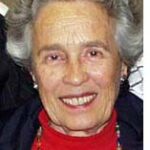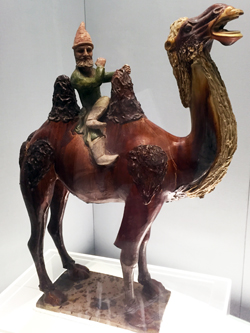By Eileen Wingard


SAN DIEGO — A highlight of my recent trip to China was in Xian, once the largest city in the ancient world and capital of China throughout 11 dynasties. After arriving by bullet train from Beijing, we had dinner at a Buddhist vegetarian restaurant and spent the evening listening to three speakers whose subject was the Chinese Jews of Kaifeng, a city on our original itinerary, but cancelled due to security reasons.
Professor Xu Xin , China’s leading scholar on the Jews of China, as well as the founder and director of the Diane and Guilford Glazer Institute for Jewish and Israel Studies at Nanjing University, gave us an overview of the history of the Jewish community of Kaifeng. Although historians may differ on the exact beginning of Jewish immigration to China, some dating the first arrival of Jews as far back as 220 BCE, what is definitely known is that during the Tang Dynasty, 618-906 CE, a poem and other records confirm the presence of Jews. Also, it is known that the Jews came on the Silk Road as traders.
In fact, a document, written on paper in a Judeo-Persian language, using Hebrew characters, was found on the Chinese-Tibet border. At that time, paper was only produced in China, so the Jewish trader had obviously been to China. These were Mizrahi Jews from Persia and Babylon. Some may also have come from India. Keifeng was then the major metropolis at the beginning of the Silk Road.
At its height, the Jewish population of Kaifeng was said to number some 5000. The first synagogue was constructed there in 1163. Stone tablets (steles), one dating from 1489, are inscribed with information about the history of the Jews in Kaifeng. The synagogue was destroyed in 1642 by floodwaters from the Yellow River. Half the population of the city was killed by that deluge. Although the synagogue was rebuilt, it was demolished by another flood in 1841.
Then began the decline of the Jewish community. Because the Jews were welcomed by their Chinese neighbors, many assimilated. Also, during that period, their last rabbi died. Although requests were sent to the outside world, no replacement rabbi was found and, since no one was able to read Hebrew anymore, the torahs and artifacts of the synagogue were sold. Yet, perhaps due to the strong reverence for ancestors, common to both the Chinese and the Jews, the Jewish descendants retained some of their Jewish practices and identity. Today, some 1000 Kaifeng residents consider themselves to be of Jewish ancestry and about 100 are actively involved in the revival of Jewish life.
In recent years, there was an Israeli teacher, Shulamit Gershowitz, who taught Hebrew and Judaica. A number of Jews from Kaifeng made aliyah to Israel where, because they adopted the Chinese tradition of patrilineal descent, they were required to undergo conversion before being admitted under the Law of Return.
Currently, Barnaby Yeh, a Jew by choice who studied at the American University in Washington, D.C. and converted to Judaism while there, teaches Torah and Talmud to the Jewish Community of Kaifeng. His father is Chinese, and Barnaby lives in Taiwan, but he travels frequently to Kaifeng. He conducted a beautiful seder there last Pesach with all the traditional foods. He translated the Haggadah into Chinese so that all could participate.
Following Professor Xu Xin’s comprehensive presentation, we heard from a prominent member of the Jewish Community of Kaifeng. He spoke to us in Chinese, as Barnaby Yeh translated. The Kaifeng Jew stressed the good relations his community always had with their Chinese neighbors and how they were fully accepted, successfully becoming civil servants and working in many professions. He was accompanied by his son, a man who appeared to be in his thirties. Both men were wearing blue kippot, the color used for kippot by the Chinese Jews.
The next day, we toured Xian’s major site, the Terra Cotta Warriors. They were built to protect the first Chinese emperor in his tomb. Each sculpture is of individual character and, along with the large army of figures on foot, there were horses and chariots. Our tour leader, Rabbi Marvin Tokayer, told us that this was one of the world’s great discoveries, comparable to the discovery of the Dead Sea Scrolls.
During the afternoon, our group visited a museum, where we saw frescoes and figurines depicting men with Semitic-looking faces, probably the Jewish traders who came to China on the Silk Road.
That evening, we attended a performance of the Tang Dynasty Song and Dance Troupe and enjoyed listening to the ancient Chinese instruments, which included wooden transverse flutes, lute-like instruments, one-string bowed instruments, hammered dulcimer-type instruments and a suspended, deep sounding drum.
Following the opening of the program, where the orchestra played by itself and accompanied singers, they reseated themselves to the side of the stage and accompanied the dance ensemble. The female dancers’ silk gowns glowed in various pastel shades of purple, blue and pink. Using long silk scarves as part of their choreography, their movements exuded beauty and grace. The men were barefoot and danced with strength and virility. Occasionally, the music evoked a mid-eastern mood, perhaps the influence of music brought by the Jewish merchants from the Middle East.
Most of the instrumental music was monophonic. Variety was achieved by featuring solos by individual instruments, especially the flute. Only at the end, with the addition of singers, was some harmony and counterpoint introduced.
Our final morning in Xian, we climbed to the top and walked along the length of the wall surrounding the old city, with views showing the growth of this bustling metropolis. We also visited a jade factory and learned about the various colors and grades of jade. We were dazzled by the jewelry and sculptures created from this semi-precious stone. There was so much to admire, the pagodas and gardens, the bullet trains and high rises, the friendliness of the people we encountered. If only we could all live in peace in our diverse and beautiful world.
The most impressive memory from my stay in Xian was the talk about the Kaifeng Jewish Community, how Jews, in spite of assimilating influences, have managed to sustain their traditions and renew their heritage. I found the story of the Kaifeng Jews an inspiration and a source of wonder. I hope, if I am ever able to visit China again, I will be able to go to Kaifeng, see the site of the synagogue, observe their Jewish School and walk on the street which still retains the name, “Teaching Torah Lane South.”
*
Wingard is a freelance writer and retired violinist with the San Diego Symphony Orchestra. You may comment to her at eileen.wingard@sdjewishworld.com
Pingback: China Tour Vegetarian | Best Vacation Tours